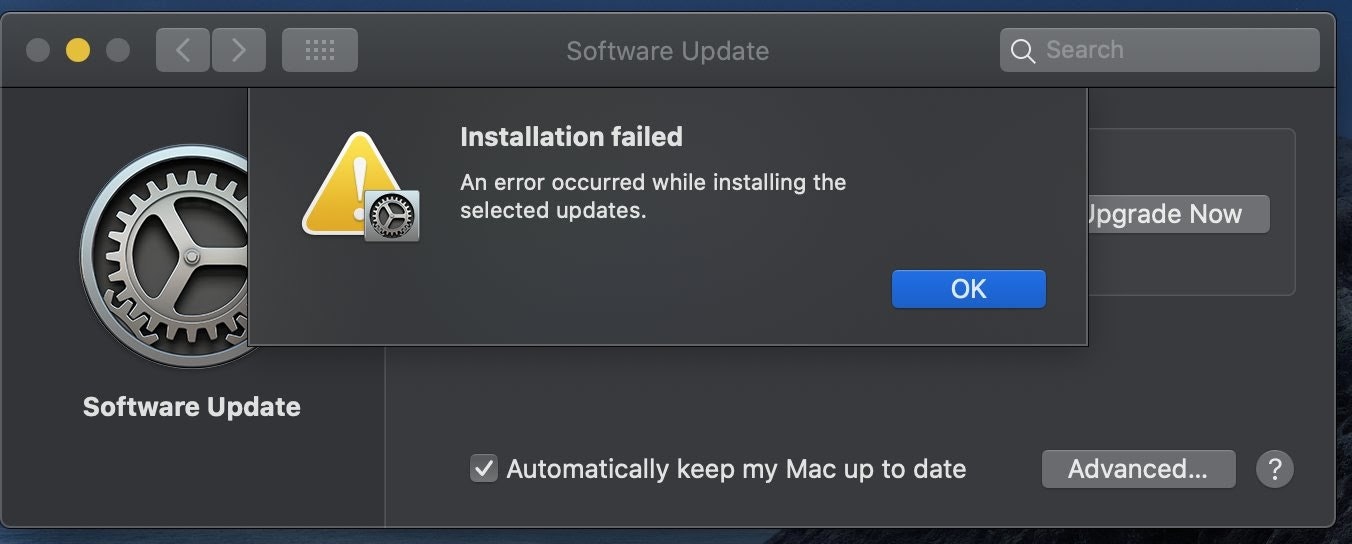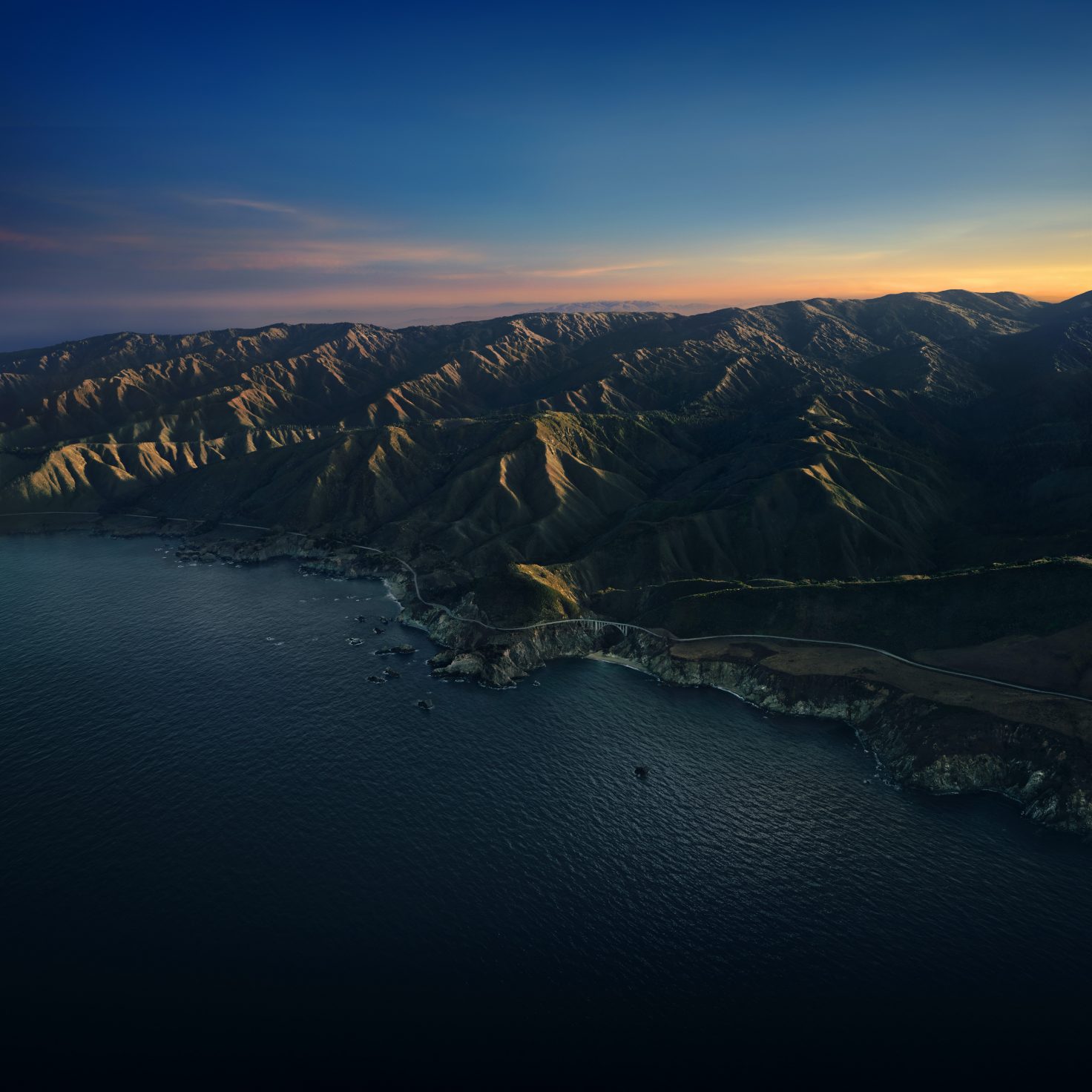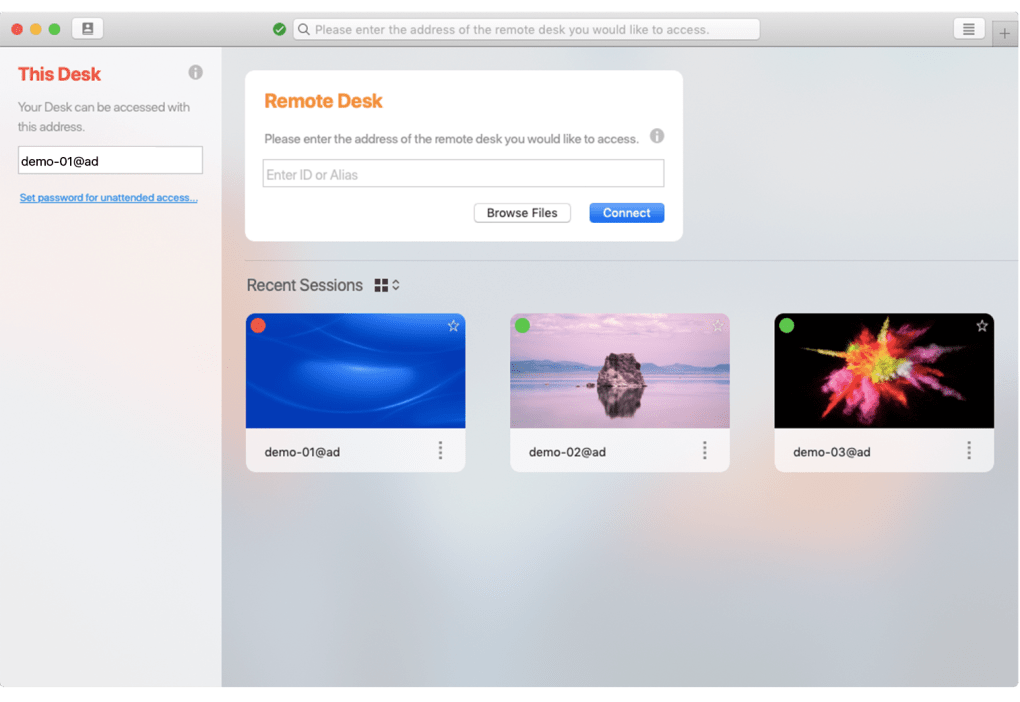Mass Deploying to Macs through Apple Remote Desktop
Representative Console Installation with Apple Remote Desktop
- From your B Series Appliance's /login interface, go to the My Account page.
- In the BeyondTrustRepresentative Console section, select Mac OS® X as your platform and click Download BeyondTrustRepresentative Console. Save the installer package to a location that you can access from Apple Remote Desktop.
The following steps outline how to convert the bomgar-rep-installer.dmg file into a .pkg file.
As with most modern Mac applications, Microsoft Remote Desktop is available for download through the Mac App Store. Go to the icon Dock on your desktop and click the blue 'App Store' icon to open it.
- Copy the code under Code for wrap_rep_installer.sh. Paste it into a text editor and save it with the file name wrap_rep_installer.sh. You must save this file to the same location where you saved the installer package.
- Copy the code under Code for rep.plist. Paste it into a text editor and save it as rep.plist. You must save this file to the same location where you saved the installer package and the wrap_rep_installer.sh file.
- In rep.plist, locate <key>RootRelativeBundlePath</key> and change its value to match your BeyondTrust support site hostname. Be sure to leave the .app file extension.
- Example: <string>BeyondTrustRepresentative Console - support.example.com.app</string>
- Save rep.plist.
- You should now have three files saved to the same location:
- bomgar-rep-installer.dmg
- wrap_rep_installer.sh
- rep.plist
- From a Terminal window, run the following command, replacing <path/to/bomgar-rep-installer.dmg> with the correct path:
- This will output a .pkg file with the same name as the .dmg (bomgar-rep-installer.pkg).
- The download includes Remote Install Mac OS X v.1.1 which: provides enhanced customization capabilities and improved performance for migration over FireWire, Ethernet and wireless networks.
- Download Microsoft Remote Desktop for macOS 10.14 or later and enjoy it on your Mac. Use Microsoft Remote Desktop for Mac to connect to a remote PC or virtual apps and desktops made available by your admin.
The rest of these steps occur in Apple Remote Desktop.
- Select a computer list in the Remote Desktop window.
- Select one or more computers in the selected computer list.
- Select Manage > Install Packages.
- Add the bomgar-rep-installer.pkg file to the package list window.
- You can set all other options to your specifications.
- Click Install. (Alternatively, you can save or schedule this installation.)
- The BeyondTrustrepresentative console silently installs. Your users can now log in to and run the representative console.
Code for wrap_rep_installer.sh
Code for rep.plist
Jump Client Installation with Apple Remote Desktop
Mac Os X Remote Desktop
- From your B Series Appliance's /login interface, go to the Jump > Jump Clients page.
- In the Jump Client Mass Deployment Wizard, be sure to check the option Attempt an Elevated Install if the Client Supports It. It is also recommended to check Start Customer Client Minimized When Session Is Started for a truly silent install. You can set all other options to your specifications. Click Create.
- Select Mac OS® X (Intel®) as your platform and click Download/Install. Save the installer package to a location that you can access from Apple Remote Desktop.
The following steps occur in Automator.

- In Automator, create a workflow. This workflow will contain three actions.
- Get Specified Finder Items
- In this action, add the Jump Client installer package (bomgar-scc-{uid}.dmg).
- Copy Items to Computers
- This action is available only if you have Apple Remote Desktop installed. It determines which computers you are allowed to install to.
- Click Update to show all of the computers you can manage.
- Check the computers to which you wish to deploy the BeyondTrust Jump Client.
- Set Destination to Other, and specify /var/root.
You can specify another location if necessary, as long as the script in the next action is able to find this location on all remote systems.
- You can set all other options to your specifications.
- Execute New UNIX Task
- Create a name for this task.
- In the text area, paste the following script, replacing {uid} with the unique identifier in the Jump Client installer file name:
- If you have allowed override of any Jump Client fields, you can append the desired command line parameters to the end of the script above. Example:
- Enter root as the user name.
- Get Specified Finder Items
- Save the workflow and click the Run button.
- While the Jump Client is installing, a splash screen will appear on the remote systems, and a BeyondTrust icon will briefly appear in the dock. If you did not check Start Customer Client Minimized When Session Is Started, then the customer client will momentarily appear as the Jump Client makes its first connection; it will then disappear.
- The Jump Client is now installed and appears in the menu bar.
- After a short interval, refresh the Jump Client interface in the representative console to see the Jump Client. As with all Jump Clients, you must have permission to access this Jump Client to see it in your list.
The latest version of Remote Install Mac OS X is unknown on Mac Informer. It is a perfect match for System Utilities in the System Tools category. The app is developed by Apple Inc. And its user rating is 3.6 out of 5. It’s easy enough to use remote access software like LogMeIn to remotely log into the Mac, download OS X from the App Store on that machine, and begin the installation process. However, a problem happens after the OS X installation process is successfully complete, which is when OS X presents the user with a series of “Setup Assistant. Download and install RemotePC™ HelpDesk on your PCs and Macs. Provide secure on-demand remote support using HelpDesk. Mac OS X 10.10 Yosemite.
These advanced steps are primarily for system administrators and others who are familiar with the command line. You don't need a bootable installer to upgrade macOS or reinstall macOS, but it can be useful when you want to install on multiple computers without downloading the installer each time.
Remote Install Mac Os X Downloads
Download macOS
Find the appropriate download link in the upgrade instructions for each macOS version:
macOS Catalina, macOS Mojave, ormacOS High Sierra
Installers for each of these macOS versions download directly to your Applications folder as an app named Install macOS Catalina, Install macOS Mojave, or Install macOS High Sierra. If the installer opens after downloading, quit it without continuing installation. Important: To get the correct installer, download from a Mac that is using macOS Sierra 10.12.5 or later, or El Capitan 10.11.6. Enterprise administrators, please download from Apple, not a locally hosted software-update server.
OS X El Capitan
El Capitan downloads as a disk image. On a Mac that is compatible with El Capitan, open the disk image and run the installer within, named InstallMacOSX.pkg. It installs an app named Install OS X El Capitan into your Applications folder. You will create the bootable installer from this app, not from the disk image or .pkg installer.
Use the 'createinstallmedia' command in Terminal

- Connect the USB flash drive or other volume that you're using for the bootable installer. Make sure that it has at least 12GB of available storage and is formatted as Mac OS Extended.
- Open Terminal, which is in the Utilities folder of your Applications folder.
- Type or paste one of the following commands in Terminal. These assume that the installer is still in your Applications folder, and MyVolume is the name of the USB flash drive or other volume you're using. If it has a different name, replace
MyVolumein these commands with the name of your volume.
Catalina:*
Mojave:*
High Sierra:*
El Capitan: - Press Return after typing the command.
- When prompted, type your administrator password and press Return again. Terminal doesn't show any characters as you type your password.
- When prompted, type
Yto confirm that you want to erase the volume, then press Return. Terminal shows the progress as the bootable installer is created. - When Terminal says that it's done, the volume will have the same name as the installer you downloaded, such as Install macOS Catalina. You can now quit Terminal and eject the volume.
* If your Mac is using macOS Sierra or earlier, include the --applicationpath argument, similar to the way this argument is used in the command for El Capitan.
Use the bootable installer
After creating the bootable installer, follow these steps to use it:
- Plug the bootable installer into a compatible Mac.
- Use Startup Manager or Startup Disk preferences to select the bootable installer as the startup disk, then start up from it. Your Mac will start up to macOS Recovery.
Learn about selecting a startup disk, including what to do if your Mac doesn't start up from it. - Choose your language, if prompted.
- A bootable installer doesn't download macOS from the Internet, but it does require the Internet to get information specific to your Mac model, such as firmware updates. If you need to connect to a Wi-Fi network, use the Wi-Fi menu in the menu bar.
- Select Install macOS (or Install OS X) from the Utilities window, then click Continue and follow the onscreen instructions.
Learn more
For more information about the createinstallmedia command and the arguments that you can use with it, make sure that the macOS installer is in your Applications folder, then enter this path in Terminal:
Catalina:

Mojave:
High Sierra:
El Capitan:

Estimated reading time: 6 minutes
Docker Desktop for Mac is the Community version of Docker for Mac.You can download Docker Desktop for Mac from Docker Hub.
By downloading Docker Desktop, you agree to the terms of the Docker Software End User License Agreement and the Docker Data Processing Agreement.
What to know before you install
How To Remote Into Mac From Windows
Relationship to Docker Machine: Installing Docker Desktop on Mac does not affect machines you created with Docker Machine. You have the option to copy containers and images from your local default machine (if one exists) to the Docker Desktop HyperKit VM. Whenyou are running Docker Desktop, you do not need Docker Machine nodes running locally (or anywhere else). With Docker Desktop, you have a new, nativevirtualization system running (HyperKit) which takes the place of theVirtualBox system.
System requirements
Your Mac must meet the following requirements to successfully install Docker Desktop:
Mac hardware must be a 2010 or a newer model, with Intel’s hardware support for memory management unit (MMU) virtualization, including Extended Page Tables (EPT) and Unrestricted Mode. You can check to see if your machine has this support by running the following command in a terminal:
sysctl kern.hv_supportIf your Mac supports the Hypervisor framework, the command prints
kern.hv_support: 1.macOS must be version 10.14 or newer. That is, Mojave or Catalina. We recommend upgrading to the latest version of macOS.
If you experience any issues after upgrading your macOS to version 10.15, you must install the latest version of Docker Desktop to be compatible with this version of macOS.
Note: Docker supports Docker Desktop on the most recent versions of macOS. Docker Desktop currently supports macOS Mojave and macOS Catalina.
As new major versions of macOS are made generally available, Docker stops supporting the oldest version and support the newest version of macOS.
At least 4 GB of RAM.
VirtualBox prior to version 4.3.30 must not be installed as it is not compatible with Docker Desktop.
What’s included in the installer
The Docker Desktop installation includes Docker Engine, Docker CLI client, Docker Compose, Notary, Kubernetes, and Credential Helper.
Remote Install Mac Os X Download Utorrent
Install and run Docker Desktop on Mac
Double-click
Docker.dmgto open the installer, then drag the Docker icon to the Applications folder.Double-click
Docker.appin the Applications folder to start Docker. (In the example below, the Applications folder is in “grid” view mode.)The Docker menu in the top status bar indicates that Docker Desktop is running, and accessible from a terminal.
If you’ve just installed the app, Docker Desktop launches the onboarding tutorial. The tutorial includes a simple exercise to build an example Docker image, run it as a container, push and save the image to Docker Hub.
Click the Docker menu () to seePreferences and other options.
OS X Mavericks download is the 9th major release of the Mac OS X versions history. It was the most powerful operating system in 2013 for Macintosh computers. The OS X Mavericks download version 10.9.1 released in December 2013 after two months from releasing the OS X Mavericks original version. This update made a number of changes to the operating system and fixed out some issues on the. Download os x mavericks installer. Though you can install Mavericks (OS X 10.9) directly from your Mac's hard drive, a bootable installer drive can be more convenient for installing the OS onto multiple Macs. And if your Mac is. Mac OS X Mavericks Free Download DMG 10.9 Bootable Installer Version. It is complete bootable Mavericks 10.9 DMG Disk Image for Clean OS Install. OS X Mavericks (version 10.9) is the tenth major release of OS X, Apple Inc.' S desktop and server operating system for Macintosh computers.
Select About Docker to verify that you have the latest version.
Congratulations! You are now successfully running Docker Desktop.
If you would like to rerun the tutorial, go to the Docker Desktop menu and select Learn.
Uninstall Docker Desktop
To unistall Docker Desktop from your Mac:

- From the Docker menu, select Troubleshoot and then select Uninstall.
- Click Uninstall to confirm your selection.
Note: Uninstalling Docker Desktop will destroy Docker containers and images local to the machine and remove the files generated by the application.
Switch between Stable and Edge versions
Docker Desktop allows you to switch between Stable and Edge releases. However, you can only have one version of Docker Desktop installed at a time. Switching between Stable and Edge versions can destabilize your development environment, particularly in cases where you switch from a newer (Edge) channel to an older (Stable) channel.
For example, containers created with a newer Edge version of Docker Desktop maynot work after you switch back to Stable because they may have been createdusing Edge features that aren’t in Stable yet. Keep this in mind asyou create and work with Edge containers, perhaps in the spirit of a playgroundspace where you are prepared to troubleshoot or start over.
Experimental features are turned on by default on Edge releases. However, when you switch from a Stable to an Edge release, you must turn on the experimental features flag to access experimental features. From the Docker Desktop menu, click Preferences > Command Line and then turn on the Enable experimental features toggle. Click Apply & Restart for the changes to take effect.
To safely switch between Edge and Stable versions, ensure you save images and export the containers you need, then uninstall the current version before installing another. For more information, see the section Save and Restore data below.
Save and restore data
You can use the following procedure to save and restore images and container data. For example, if you want to switch between Edge and Stable, or to reset your VM disk:
Use
docker save -o images.tar image1 [image2 ..]to save any images you want to keep. See save in the Docker Engine command line reference.Use
docker export -o myContainner1.tar container1to export containers you want to keep. See export in the Docker Engine command line reference.Uninstall the current version of Docker Desktop and install a different version (Stable or Edge), or reset your VM disk.
Use
docker load -i images.tarto reload previously saved images. See load in the Docker Engine.Use
docker import -i myContainer1.tarto create a filesystem image corresponding to the previously exported containers. See import in the Docker Engine.
For information on how to back up and restore data volumes, see Backup, restore, or migrate data volumes.
Where to go next
Remote Install Mac Os X Download Torrent
- Getting started provides an overview of Docker Desktop on Mac, basic Docker command examples, how to get help or give feedback, and links to other topics about Docker Desktop on Mac.
- Troubleshooting describes common problems, workarounds, howto run and submit diagnostics, and submit issues.
- FAQs provide answers to frequently asked questions.
- Release notes lists component updates, new features, andimprovements associated with Stable releases. For information about Edge releases, seeEdge release notes.
- Get started with Docker provides a general Docker tutorial.